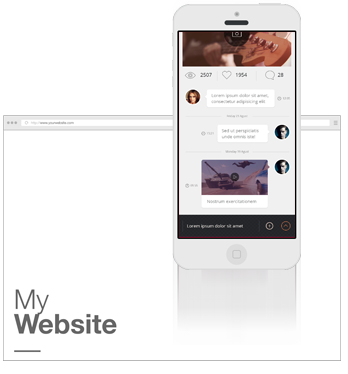Spread the word
Having developed and published a great Android App is not enough. If you want to sell it to a lot of people and earn good money, you will have to promote it. Blogging, tweeting, Facebook-ing, emailing, etc. are a great way to spread the word. But how do you differentiate your app in the big pool of great apps? A simple yet effective way to do this is to include an interactive demo in your posts and articles, so that people can experience your app, see how it works and "connect" to it. This way, they are more likely to buy your app.
This guide shows you how to create an online interactive demo of your Android app - like the one you see on the right-hand side - in just a couple of minutes, for free. Your demo will be interactive, guided, online, easy to embed in your website or blog, and will run in the browser or on an Android device. So, the perfect tool to promote your app!
1Make up your mind about the scenario you want to demo
One of the best selling scenario is showing your potential users how your app solves one of their problems.
2Take screenshots of this scenario, screen by screen
The easiest way to take screenshots of your Android app is directly from the Android Emulator. However, you can take screenshots also from your phone, but the method will work only on some phones. If you have a Samsung Galaxy, you can capture a screen by pressing and holding the Back button and then pressing the Home button. Your screenshots will then appear in the Gallery, in a separate folder called ScreenCapture. When done, send the screenshots to your PC.
3Sign up to AppDemoStore.com
You can sign in from your desktop or mobile device (no credit card details needed). Once signed in, you will be directed to "My Demos" page.
4Create a new demo and Upload your screenshots to it
In the section "My Demos", click the "Create Demo" button. Select a frame from the gallery (the latest Google Nexus, Samsung Galaxy & HTM frames are always available). The frame will be visible when the demo is viewed on a computer and not visible when viewed on a mobile device. The frame can be changed later.
Upload your screenshots to your demo by clicking the button "Upload Screenshots" and selecting the files from your disk. Multiple file upload is possible, but you can upload a maximum of 10 screenshots at once. To upload more screenshots, just use the button "Upload Screenshots" several times.
Scrollable Screens: To create scrollable screens, just upload a long image and then set its property "Image Layout" to "scroll". More details here.
5Add interaction, animations and annotations.
- Use the "Hotspot" control to add interaction between your screenshots. You can choose the transition effect between screens (slide up/down, fade). More details here.
- Use the "Textbox", "Callout" and "Link" controls to add annotations, explanations, auto-typing and links.
- Use the "Timer" control to simulate loading effects or show a screen for a limited time (e.g. splash screen).
- Use the "Arrow" control to add customizable arrows. More details here.
- Use the "iFrame" control to embed webpages in your demo.
- Use the "Image" control to add small images on top of the screenshots.
- Use the "Video" control to embed a YouTube video or a video stored on a server. More details here.
- Use the "Sound" control to upload audio files or provide a text to be spoken with our Text-to-Speech functionality. More details here.
- Use the "User Input" control to let users type information into a field that is carried over to the next screens. More details here.
The demo is HTML-based, thus runs in any desktop or mobile browser.

Common use cases for using your demo
- Share the link to your demo via Email or social networks.
- Embed demo in your website or HTML email.
- Embed the demo into your Facebook Page. Learn how to do this here.
- Embed demo in your app. Learn how to do this here.
- Download your demo as an HTML, ZIP or APK or PDF.
- Capture leads and feedback with your demo.
- Get in-depth demo analytics such as where did user click, interaction flow, exit screens, etc. More details here.
- Use it as a starting point for generating a demo video for your app. More details here.